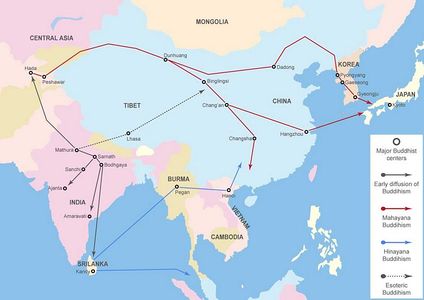Tang and Silla: Originality of Silla Culture and the Influence of Tang China
The culture of the Silla kingdom was both directly and indirectly influenced by China. While Silla waged war with the Tang dynasty on and off for many years, it took due note of Tang's political systems. Silla, aspiring to build a unified nation with strong royal authority, adopted the Tang’s political systems centering on the emperor. It also stressed Confucian political ideologies, establishing a national Confucian education institute and a civil service examination system based on Confucian texts.
Many Silla scholars went to study in China and the best of them were selected through examinations to serve as government officials, most notably Choe Chi-won (최치원, 崔致遠, 857-?). Silla Buddhist monks also went to study in China, the most famous being Uisang (의상, 義湘, 625-702), who established the Flower Garland School of Buddhism in Korea when he returned.
Active exchange between Silla and Tang is evidenced by the residential areas and Buddhist temples for the Silla people that existed in the Tang capital of Chang'an (today's Xi'an). In the 9th century, a trading port named Cheonghaejin was established on an island in the south west coast of the Korean peninsula for maritime trade between Silla and Tang.
But Silla culture should not be seen as a copy of Chinese culture. While Silla actively adopted the advanced civilization of Tang, many intellectuals stressed the importance of their native culture. For example, the Tang civil service examination system was not fully implemented because of Silla's unique social class system, the "bone rank system," which regulated political and social activities according to birth and blood ties.
The great Buddhist master Wonhyo (원효, 元曉, 617-686) was one of the most influential intellectual leaders of Silla. According to legend, Wonhyo was on his way to study in Tang with his friend Uisang when he attained enlightenment, and therefore decided not to go to Tang. This story demonstrates that Korean Buddhism, as led by Wonhyo, developed distinctly from that of China. The intellectual accomplishments of Wonhyo and Uisang influenced the further development of Buddhism in China and Asia for the next millennium. Wonhyo's son, Seolchong (설총, 薛聰, 655-?), a Confucian scholar, was credited with systemizing idu, a method of writing the Korean language using Chinese characters. The achievements of figures like these attest to the way Silla's culture shared mutual influences with Tang as it developed into a rich culture with its own unique identity.
Portrait of National Preceptor Uisang (Son Yeon-chil, 1991)[1]
Portrait of Wonhyo (Yi Jong-sang, 1978)[2]
Portrait of Seolchong (Gwon O-chang, 1992)[3]







